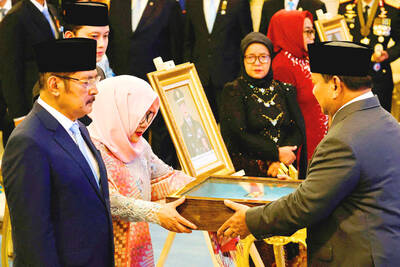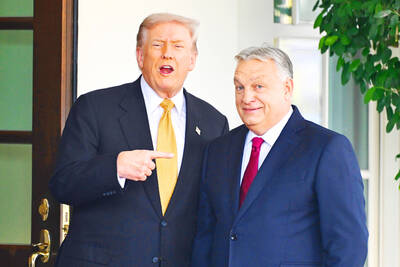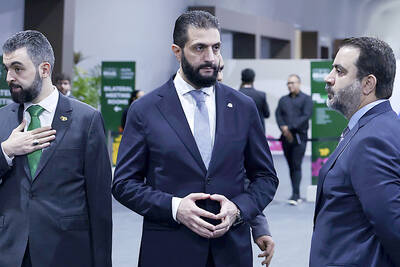The Kremlin has forced thousands of migrants and foreign students to fight alongside Russian troops in its war against Ukraine, adding extra personnel for its offensive in the Kharkiv Oblast, according to assessments from European officials.
Using tactics first deployed by the Wagner mercenary group, Russian officials have with increasing frequency been threatening not to extend the visas of African students and young workers unless they agree to join the military, officials familiar with the matter said.
Moscow has also been enlisting convicts from its prisons, while some Africans in Russia on work visas have been detained and forced to decide between deportation or fighting, one European official said.

Photo: The Russian Defense Ministry Press Service via AP
Some of those people had been able to bribe officials to stay in the country and avoid military service, said the official, who like other people cited spoke on condition of anonymity.
Russia’s practice of sending migrants and students into battle under duress dates back to earlier in the war, another European official said.
Those troops suffer especially high casualty rates, because they are increasingly deployed in risky offensive maneuvers to protect more highly trained units, the official said.
A Russian Ministry of Foreign Affairs spokeswoman did not respond to an e-mail seeking comment.
Russia has engaged in a global recruitment drive to enlist foreign mercenaries in at least 21 countries, including several nations in Africa, reports citing Ukrainian intelligence say.
Army recruitment campaigns offer lucrative signing bonuses and salaries for those who join up as contract soldiers. Recruiters have also targeted migrants and students who previously looked for employment in Russia, and in some cases have lured others over with promises of lucrative work before forcing them to train and deploy to the front, the reports say.
Russia’s ability to mobilize far greater numbers of troops could become a significant factor in the war as Russian President Vladimir Putin seeks to capitalize on a shift in momentum this year.
For now though, his forces have been grinding forward only slowly in northeastern Ukraine with heavy losses, despite a shortage of troops and ammunition on the Ukrainian side.
The Russian military lost more than 1,200 people a day last month — its highest casualty rate of the war, the British Ministry of Defence said.
From the beginning of the invasion, Russia has seen about 500,000 personnel killed or wounded, the UK estimates.
Bloomberg was unable to independently verify those figures.
At a meeting with foreign media in Saint Petersburg late on Wednesday last week, Putin appeared to imply that about 10,000 Russian troops a month are being killed or wounded, and that Ukrainian losses are five times higher.
While the Kremlin has failed to achieve a breakthrough on the battlefield, it has stepped up a bombing campaign against Kharkiv, Ukraine’s second-largest city.
Western officials say those attacks appear designed to make the city uninhabitable.
As he seeks to maintain public support in Russia, Putin has so far resisted a full-scale mobilization and Russia says it has been able to make up a significant share of its losses — in terms of numbers if not the standard of the troops — through a voluntary recruitment drive that has attracted tens of thousands of people.
The government in Kathmandu earlier this year said that it was aware of about 400 young Nepali men who had been recruited by Russia, but many more likely signed up without the government knowing.
India’s decision to stop recruiting Nepalese Gurkhas for its army, ending a 200-year-old tradition, may have encouraged Nepalis to look for work in Russia and elsewhere.
A senior Ukrainian official said they have seen an uptick in the number of foreign fighters among the prisoners Ukraine has captured on the battlefield.
Africans and Nepalis have been particularly common, they said.
Reuters reported last year that the mercenary group Wagner had recruited several African citizens as part of a drive to enlist convicts from Russian prisons for its forces in Ukraine.
There are 35,000 to 37,000 African students in Russia, said Yevgeny Primakov head of Rossotrudnichestvo, an organization devoted to spreading knowledge about Russia abroad.
“Every year we sign up about 6,500 students from Africa to study in Russia for free,” he said on Thursday at the Saint Petersburg International Economic Forum.

James Watson — the Nobel laureate co-credited with the pivotal discovery of DNA’s double-helix structure, but whose career was later tainted by his repeated racist remarks — has died, his former lab said on Friday. He was 97. The eminent biologist died on Thursday in hospice care on Long Island in New York, announced the Cold Spring Harbor Laboratory, where he was based for much of his career. Watson became among the 20th century’s most storied scientists for his 1953 breakthrough discovery of the double helix with researcher partner Francis Crick. Along with Crick and Maurice Wilkins, he shared the

OUTRAGE: The former strongman was accused of corruption and responsibility for the killings of hundreds of thousands of political opponents during his time in office Indonesia yesterday awarded the title of national hero to late president Suharto, provoking outrage from rights groups who said the move was an attempt to whitewash decades of human rights abuses and corruption that took place during his 32 years in power. Suharto was a US ally during the Cold War who presided over decades of authoritarian rule, during which up to 1 million political opponents were killed, until he was toppled by protests in 1998. He was one of 10 people recognized by Indonesian President Prabowo Subianto in a televised ceremony held at the presidential palace in Jakarta to mark National

US President Donald Trump handed Hungarian Prime Minister Viktor Orban a one-year exemption from sanctions for buying Russian oil and gas after the close right-wing allies held a chummy White House meeting on Friday. Trump slapped sanctions on Moscow’s two largest oil companies last month after losing patience with Russian President Vladimir Putin over his refusal to end the nearly four-year-old invasion of Ukraine. However, while Trump has pushed other European countries to stop buying oil that he says funds Moscow’s war machine, Orban used his first trip to the White House since Trump’s return to power to push for

LANDMARK: After first meeting Trump in Riyadh in May, al-Sharaa’s visit to the White House today would be the first by a Syrian leader since the country’s independence Syrian President Ahmed al-Sharaa arrived in the US on Saturday for a landmark official visit, his country’s state news agency SANA reported, a day after Washington removed him from a terrorism blacklist. Sharaa, whose rebel forces ousted long-time former Syrian president Bashar al-Assad late last year, is due to meet US President Donald Trump at the White House today. It is the first such visit by a Syrian president since the country’s independence in 1946, according to analysts. The interim leader met Trump for the first time in Riyadh during the US president’s regional tour in May. US envoy to Syria Tom Barrack earlier